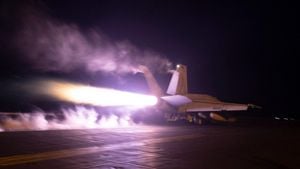Modern warfare is undergoing radical transformations as drones and artificial intelligence (AI) take center stage, leading to predictions of significant changes to how conflicts are fought. Eric Schmidt, the former CEO of Google, recently pronounced this shift, emphasizing the rapid evolution of warfare technology and how traditional combat systems like tanks and artillery may soon become relics of the past.
Schmidt highlighted the effectiveness and cost-efficiency of unmanned aerial systems, indicating how these technologies are changing battlefield dynamics almost daily. He noted, for example, how low-cost drones can neutralize high-value military assets, making them game-changers on the modern battlefield.
On November 12, 2024, Schmidt remarked, "Drone warfare is fundamentally altering the landscapes of conflict." His statement encapsulates the sentiment shared by many defense analysts who see the rise of drones as not merely technological speculation but as reality shaping military strategies worldwide.
These predictions are underscored by recent developments in Ukraine, where drones have become indispensable tools for both reconnaissance and direct strikes against enemy personnel and equipment. Schmidt pointed out how affordable first-person view (FPV) drones are playing significant roles within this conflict, demonstrating how nations with limited resources can effectively challenge heavily armored forces.
The affordability and accessibility of drone technology mean smaller nations or non-state actors can deploy sophisticated means of warfare without hefty investments. This democratization of military power raises some eyebrows among global powers, worrying about the changing game of defense strategies.
Defense analysts suggest Schmidt's remarks point toward shifting defense policies. The trend is clearly moving toward investing more heavily in AI and autonomous systems, emphasizing cost-effective and high-precision capabilities over traditional heavy armory.
The impact of this shift isn't confined to just one region. For example, on the same day Schmidt made his comments, Ukrainian drones successfully targeted an oil depot within Russia's Belgorod Oblast, achieving what many see as another step toward sophisticated unmanned warfare. This attack was precise, igniting significant infrastructure, though rapid firefighting responses mitigated more extensive damage.
This strike is part of Ukraine's broader strategy to target Russian energy sectors, demonstrating how unmanned systems can be used effectively for impactful strikes with relatively small payloads. Such tactics highlight the potential of drones as cost-effective tools to undermine enemy resources.
Ukraine’s commitment to advancing its military drone capabilities is evident through the establishment of the Unmanned Systems Forces as its own military branch. This move indicates Ukraine’s strategic plan to ramp up drone production, with aspirations to manufacture up to one million drones by 2024.
Such ambitious targets signal Ukraine's intent to modernize its military capabilities to match, if not surpass, those of its adversaries. International partnerships and localized production are fueling this rapid expansion, emphasizing how drone warfare is becoming central to military strategies.
The global response reflects this urgent trend. Countries around the world are now prioritizing investments toward enhancing their own drone technology and AI capabilities. This shift inevitably leads to heightened competition for drone supremacy among nations, thereby influencing alliances, defense budgets, and military doctrines.
During military training exercises, the role of unmanned systems is increasingly recognized for their effectiveness, adapting the thought processes of military planners and strategists. Some suggest the current arms race is not just about quantity but skilled strategic applications of these new technologies.
It's clear from discussions around defense expenditures—Ukraine's proposed 2025 defense budget allocates about $1.3 billion solely for weapon production—that nations are gearing up for the future. This marked increase reflects the urgency with which these countries are addressing security needs amid growing threats and uncertainties about upcoming international support.
The Ukrainian drone strike and Schmidt’s insights collectively raise significant questions about the future of conflicts: how will nations protect their infrastructures closely linked to national security, and how will those defenses adapt to increasingly sophisticated drone capabilities? Future wars could be dominated by rapid technological advancements where traditional forms of warfare become less relevant.
With wars likely becoming faster and more unpredictable, the study of AI-driven drone technology will need to be closely monitored. Nations now have to rethink their military strategies and preparedness. The increasing sophistication of drone warfare may lead to redefining how conflicts begin and end, reshaping defense operations worldwide.
The message is clear: as the world witnesses the rise of drones and AI shaping modern combat, military engagement paradigms could be on the brink of transformation. The future of warfare will likely demand adaptability and foresight on the part of military leaders, emphasizing the relevance of agility as power balances shift.
This compelling narrative serves as both a warning and call to action for nations and their military establishments. The emphasis is not just on equipping forces with the latest technology but fully integrating unmanned systems within the strategic fabric of military operations.



